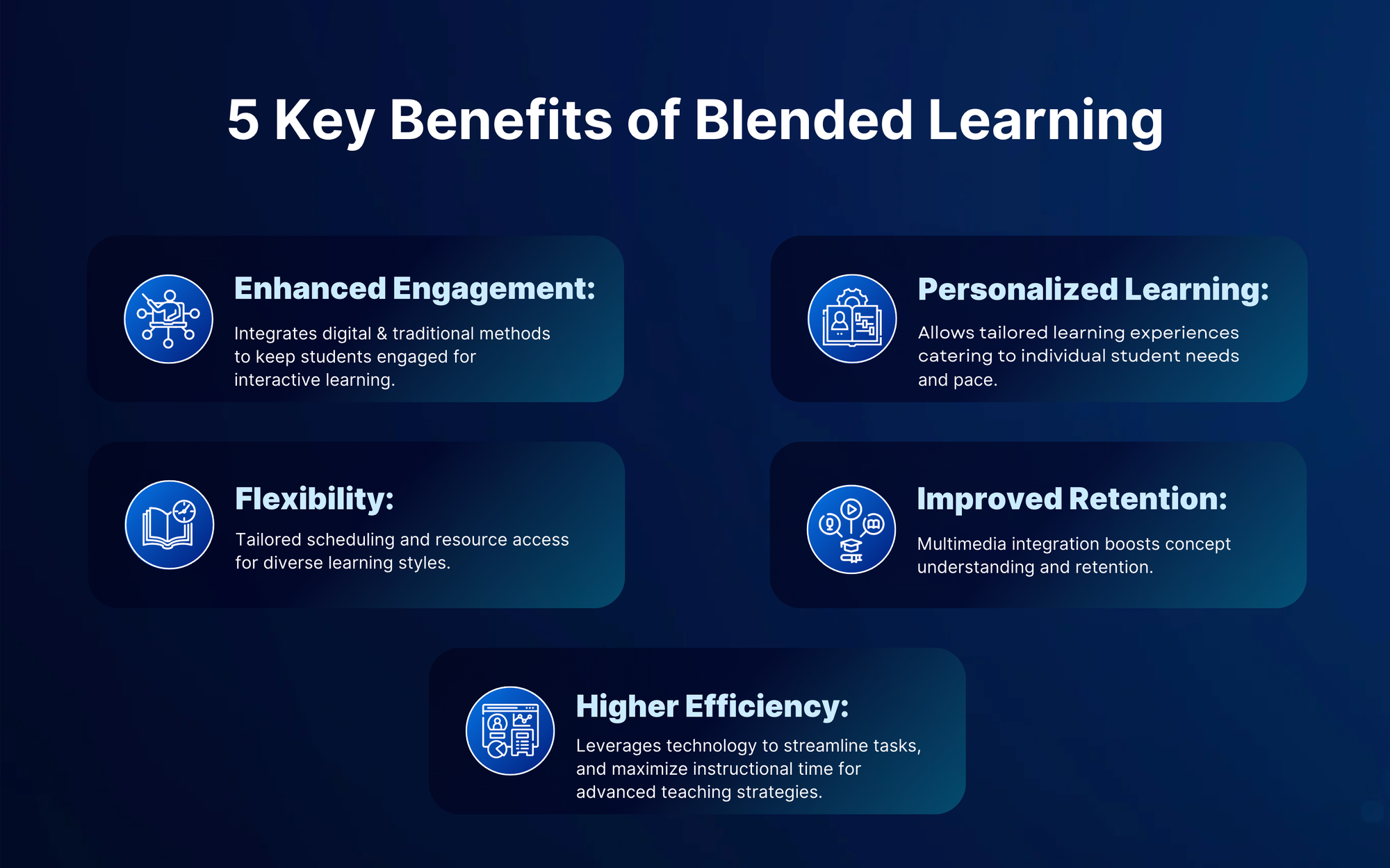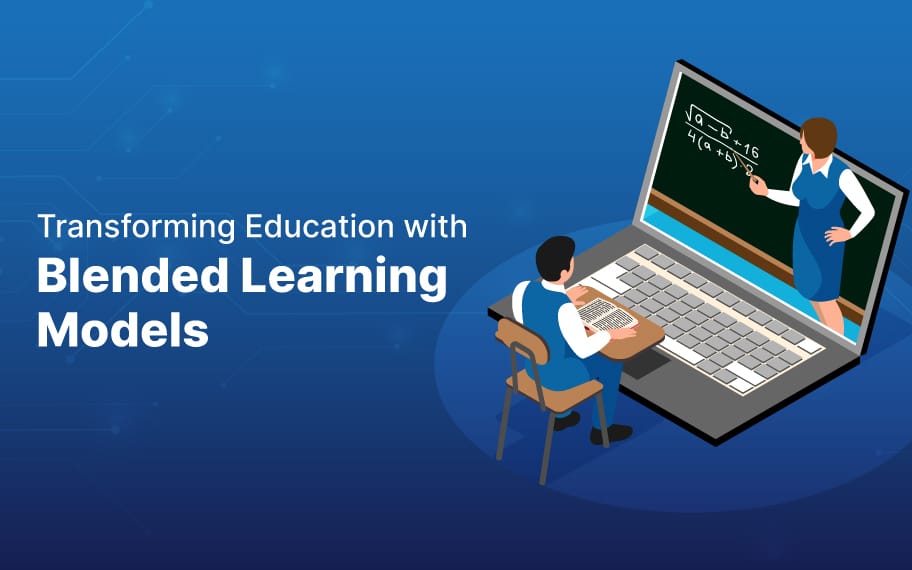Education in the twenty-first century is more than merely writing down what is being taught and learning it. The educational system is undergoing a redesign in accordance with technological advancements.
If you've heard of online learning, you've most likely heard of blended learning. The approach has grown more popular in recent years. According to research by Blackboard, 76% of teachers say blended learning increases engagement and knowledge retention, 59% of students are more motivated, and 85% say it offers more personalized learning.
It'll not be wrong to say that if blended learning were a recipe, it'd be the perfect blend of tech, textbooks, and a sprinkle of student enthusiasm!
Consequently, school leaders are willingly embracing its benefits for better learning outcomes. Discover how the blended learning approach integrates the advantages of conventional classroom teaching with developing technologies to make learning simpler, relevant, and interactive.
Blended Learning: The Meaning
Blended learning, popular among educational institutions as hybrid learning, is a winning blend of conventional classroom learning and online learning tools. In layman's language, it centers around integrating the use of digital tools, processes, and resources into a traditional classroom. This approach encourages result based learning by fostering greater knowledge retention.
Blended learning allows self-paced learning for students of all levels, allowing those with quick learning abilities to gain knowledge with greater efficiency. On the contrary, students who are slow learners can go at their own rate while getting personalized assistance where they are getting stuck. It blends the ease of online resources, virtual communication, and self-paced learning with in-person experiences, group discussions, hands-on projects, engaging multimedia content, gamified components, and collaborative online projects.
Different Models of Blended Learning To Enhance Learning Experiences
Blended learning is not just limited to the computer screens of students and teachers. There are different ways schools can offer this learner oriented learning. The major models include:
Face-to-Face Model
The face-to-face model is the most similar to a regular school setting. With this technique, the implementation of online learning will be chosen on an individual student basis. Students who are having difficulty or performing above grade level can use the face-to-face learning strategy to use technology during class and move ahead at their own pace.
Teachers get to monitor student progress and give them assignments via a virtual platform. Based on the situation at hand, this is carried out to bridge knowledge gaps, reinforce teachings, or present fresh challenges for the students to tackle and learn new concepts.

Flex Model
This model focuses on the online delivery of knowledge. Learning is mostly self-guided, with teachers present to offer personalized assistance when needed. Students explore and use innovative ideas on their own in a digital setting. While teachers create classroom experiences and provide the necessary assistance, students can work through the modules independently.
The blended learning flex model places a strong emphasis on digital content delivery. It is usually used at schools with a large proportion of underperforming or slow learners. It encourages students to become more imaginative and explore various opportunities for learning, such as technological devices or experiential learning.
Rotation Model
In this type of blended learning, students engage at various stations according to a set timetable, either online or in person with the teacher. This entails combining interactive displays, digital signs, and e-learning platforms to improve the learning atmosphere and deliver content effectively. There are three kinds of rotation models:
- Station rotation: Students go between several learning stations, some of which offer online materials like desktop or tablet activities.
- Individual rotation: Students follow a timetable established by their teachers to rotate on a case-by-case basis.
- Lab rotation: Students have to spend a set amount of time in a computer lab where multiple groups of students can connect at the same time.
Online Driver Model
On the other end of the road from the face-to-face driver, we've got the online driver. In this type of blended learning, students work at their own pace, remotely, and coursework is mostly supplied via an online platform.
The online driver strategy is appropriate for students who require more adaptability and liberty in their everyday lives. Students and teachers are able to connect via discussion groups, email, or chat. Despite its versatility, it lacks face-to-face interaction.
The most effective way to let students take charge of their own learning and maintain close tabs on their progress as they study using multimedia content and eventually participate in class discussions is through an LMS.
Benefits of Blended Learning for Students & Teachers
When we find the perfect balance among digital tools, students, teachers, and classroom settings, blended learning offers the ideal learning environment. Here are some of the benefits you can expect from blended learning:
For Students
- Freedom to log on and work through courses, lectures, and other resources at their own pace
- Liberty of having to speak up for themselves and take responsibility for what they learn. As a result, they may be better prepared for both their further study and career.
- Ability to experiment with innovative programs and equipment. Learning how to use such technologies can help them get ready for new projects.
- Access to study important concepts and subjects online prior to in-person lectures for practical activities
For Teachers
- Provides access to a broad range of resources that they can use to create lesson plans for various situations
- Allows evaluation of their students' progress in real-time with the help of online resources and platforms
- Empowers them to create internet-based resources and focus on personalizing their face-to-face class sessions according to the requirements of their students
- Streamlines routine and repetitive duties, including assignments, progress reports, and class schedules, through automation
Wrapping Up!
Learning is an ever-evolving process. Embracing the advancements in learning technologies, educational institutions can build a better learning framework for their students and teachers. Blended learning is one of the babies of learning advancements that has transformed the way students learn, and teachers teach using innovative techniques and conventional classroom settings. Inculcate the different blended learning models and metamorphose the way your institution educates.
Learn more about Teachmint plans here.











